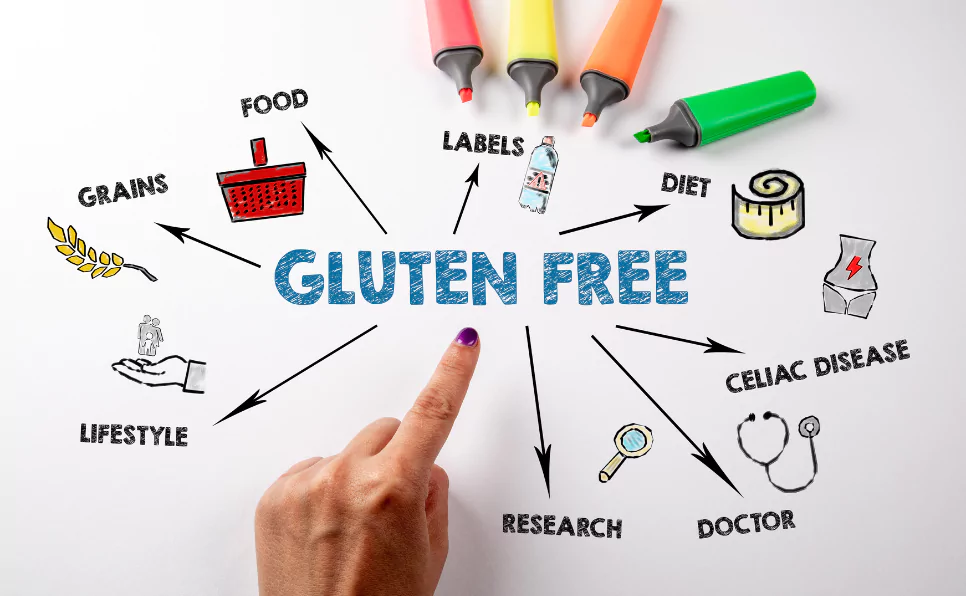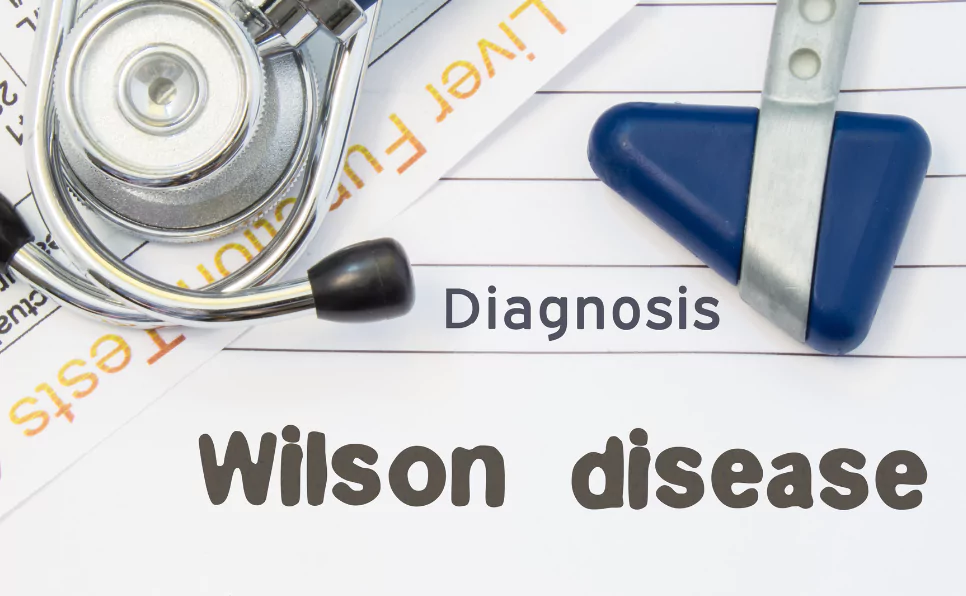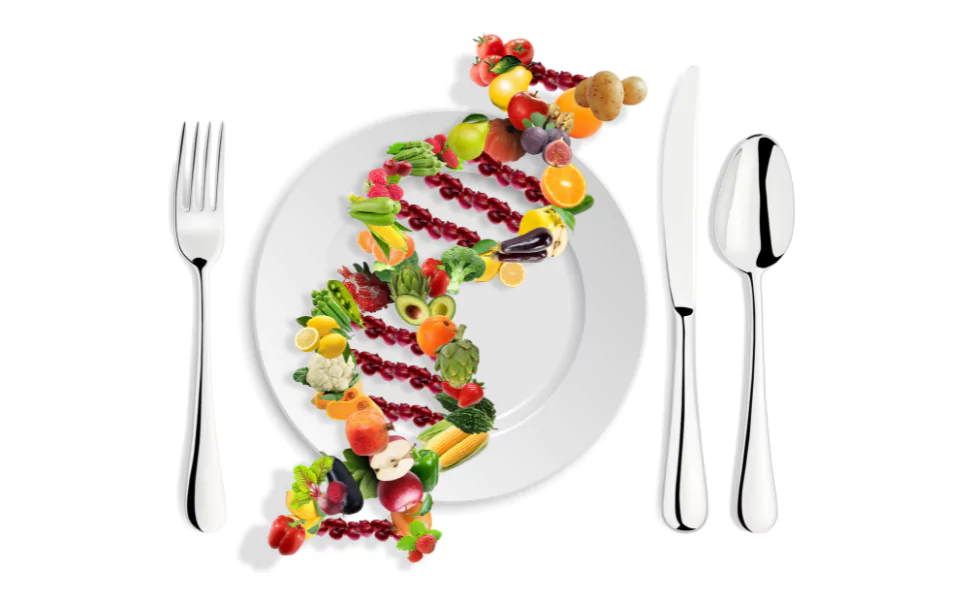Celiac disease is a lasting immune disease that impacts around 1% of all people. It happens when your body has a reaction to gluten, a protein in wheat, barley, rye, and some other grains. Gluten causes an immune reaction that injures the inner surface of the small intestine, leading to a range of signs and problems.
Knowing celiac disease and its inherited parts can aid people with the celiac disease better handling their condition by sticking to a strict gluten-free diet. It can help people who could develop celiac disease to get checked and diagnosed sooner.
In this article, we will explain what celiac disease is, how it is diagnosed, its symptoms and problems, and how it is linked to genetics. We will also give some advice on living without gluten and dealing with celiac disease.
What is Celiac Disease?
Celiac disease is an autoimmune disease, meaning that the body’s immune system mistakenly harms its own tissues.
In the case of celiac disease, the immune system aims at the villi, tiny finger-like extensions lining the small intestine that help absorb food nutrients. When these villi get damaged, the body can’t properly break down and take in gluten and other nutrients, leading to poor nutrition and several symptoms.
Here are some common symptoms of celiac disease:
- Diarrhea
- Tiredness
- Weight loss
- Bloating and gas
- Pain in the stomach area
- Feeling like throwing up and actually doing so
- Constipation
However, some people with celiac disease might not have any digestive signs at all. Instead, they might notice other symptoms not related to the digestive system, like:
- Anemia (low number of red blood cells)
- Osteoporosis (loss of bone thickness)
- Dermatitis herpetiformis (an itchy, bubbly skin rash)
- Mouth sores
- Headaches and fatigue
- Problems with the nervous system (such as numbness, tingling, issues with balance, or cognitive impairment)
- Pain in the joints
- Less functional spleen
Celiac disease can also impact children differently than adults. Kids with celiac disease might have issues with growth and development, such as:
- Failure to thrive (not gaining weight or growing well)
- Damage to tooth enamel
- Short stature
- Delayed puberty
- Neurological problems (such as attention-deficit/hyperactivity disorder, learning disabilities, headaches, seizures, or lack of muscle coordination)
If celiac disease is not treated, it can lead to serious problems over time. Some possible complications include:
- Lactose intolerance (trouble digesting dairy products)
- Malabsorption syndromes (like deficiencies in vitamins or imbalances in electrolytes)
- Cancer (especially in the small intestine or lymphoma)
- Infertility or miscarriage
- Autoimmune diseases (like type 1 diabetes, thyroid disease, or Addison’s disease)
The only way to treat celiac disease is by following a strict gluten-free diet forever. This means avoiding all foods with gluten or contaminated by gluten. Gluten-free foods include meat, fish, eggs, dairy products (unless you’re lactose intolerant), fruits, vegetables, rice, potatoes, lentils, and some grains (like quinoa or buckwheat). You can also find many gluten-free products in supermarkets and online stores.
To diagnose celiac disease, doctors usually perform a blood test that checks the levels of antibodies against gluten in the blood.
These antibodies are made by the immune system when gluten is consumed. If the blood test shows positive for celiac antibodies, then a small intestine biopsy is usually performed to confirm the diagnosis.
In a biopsy, a small sample of tissue is taken from the lining of the small intestine and looked at under a microscope to check for signs of damage.
Is Celiac Disease Genetic?
Yes, celiac disease is genetic, meaning it runs in families. Individuals with first-degree relatives, such as parents, siblings, or children, who have celiac disease are at a higher risk of developing the condition themselves. Specifically, the risk for these family members ranges from 4% to 15%. This increased risk is due to shared genetic markers associated with celiac disease, underscoring the importance of genetic factors in the development of this autoimmune disorder.
So, Celiac disease isn’t just caused by what we eat or the environment around us, like gluten exposure.

The genetic part of celiac disease involves traits we receive from our parents through genes. These genes are like pieces of our DNA that carry instructions for making proteins. Small differences in these genes between individuals, called alleles, can increase or decrease the chances of getting certain diseases, including celiac disease.
Celiac disease is a bit complicated genetically because more than one gene contributes to it.
However, carrying these genes doesn’t mean a person will definitely develop the disease. Other factors, such as environmental triggers, also play a role. Therefore, these genes are required but not the only thing causing celiac disease.
The role of HLA-DQ2 and HLA-DQ8 genes in celiac disease
Two genes, named HLA-DQ2 and HLA-DQ8, are the most significant genetic factors connected to celiac disease. They are part of a group of genes known as the human leukocyte antigen (HLA) system, responsible for controlling our immune system and helping it identify foreign substances like bacteria and viruses.
HLA-DQ2 and HLA-DQ8 produce proteins that appear on certain immune cells called antigen-presenting cells (APCs). These proteins attach to gluten fragments that have been partially digested in the intestine and present them to another type of immune cells known as T cells.
These T cells usually protect us from harmful invaders, but in celiac patients, they mistake gluten as a threat and start an inflammatory response damaging the intestine lining.
About 95% of people with celiac disease have one or both copies of the HLA-DQ2 gene, while around 5% only have the HLA-DQ8 gene.
However, these genes are also commonly found in people without celiac disease. This means having these genes alone doesn’t cause celiac disease but increases the risk when exposed to gluten.
Other genes contributing to celiac disease
Besides HLA-DQ2 and HLA-DQ8, many other genes can increase the risk of celiac disease. These genes, called non-HLA genes, play various roles in processes affecting the immune response, the function of the intestinal barrier, or the metabolism of gluten.
Examples of these non-HLA genes include:
- CELIAC1: Makes a protein that regulates the expression of other genes involved in inflammation.
- SH2B3: Makes a protein that affects the activation and differentiation of T cells.
- IL18RAP: Makes a protein involved in the signaling pathway of a cytokine that promotes inflammation.
- IL21: Makes a protein that stimulates the production of antibodies.
- IL2RA: Makes a protein that binds to a cytokine regulating the growth and function of T cells.
- RGS1: Makes a protein that regulates the signaling pathway of molecules attracting immune cells to inflammation sites.
- CTLA4: Makes a protein that acts as a negative regulator of T cell activation.
- MYO9B: Makes a protein that regulates the cytoskeleton and the permeability of the intestinal lining.
- PARD3: Makes a protein that controls the polarity and tight junctions of intestinal cells.
- DPP4: Makes a protein that cleaves gluten peptides and may affect their immunogenicity.
These non-HLA genes have less effect on the risk of celiac disease than HLA-DQ2 and HLA-DQ8, and each contributes just a little to the genetic risk.
However, they can interact with each other or with environmental factors to change the course of the disease. There might also be other undiscovered genes contributing to the susceptibility of celiac disease.
Is Celiac Disease Hereditary?
Absolutely, celiac disease is considered hereditary, as it shows a significant tendency to occur within families. If you have a first-degree relative — meaning a parent, sibling, or child — with celiac disease, your likelihood of developing the disease is notably higher, estimated to be between 4% and 15%. This familial risk highlights the role of heredity in the transmission of celiac disease, pointing to specific genetic markers that contribute to its onset. Understanding these genetic factors is crucial for early detection and management of the condition in families where celiac disease is present.
Genetic Testing For Celiac Disease in Diagnosing and Family Screening
Genetic testing for celiac disease can identify the presence of specific HLA (human leukocyte antigen) genes known to increase the risk for the condition, namely HLA-DQ2 and HLA-DQ8. While not everyone with these genes will develop celiac disease, nearly all individuals with the condition possess one or both.
This testing is particularly useful for individuals with a family history of celiac disease, aiding in risk assessment and early detection. It’s a critical tool for those with related symptoms or for relatives of celiac patients, providing clarity on their genetic predisposition.
Genetic testing for celiac disease can be helpful in diagnosis and family screening. However, a positive result for these genes cannot confirm celiac disease because they alone can’t cause the disease.
Early detection can prevent complications from celiac disease as these at-risk relatives can get regular blood tests and start a gluten-free diet if symptoms or antibodies appear.
So, genetic testing for celiac disease is not a replacement for other diagnostic methods, like blood tests and intestinal biopsy, but a supplementary tool for ruling out celiac disease in doubtful cases.
Gluten-Free Diet in Celiac Disease
Gluten is a protein that is found in various grains like wheat, barley, and rye. Gluten works like a sticky substance that helps keep the food together. You might be surprised to find gluten in unexpected foods, such as sauces, salad dressings, soups, and malt products.

For the majority of us, eating gluten isn’t an issue. But for people living with celiac disease, consuming gluten causes an immune reaction which damages their small intestine.
Celiac disease, also known as celiac sprue or gluten-sensitive enteropathy, is a long-term immune disorder that affects roughly 1 out of 100 people.
Celiac disease leads to damaged villi and they can’t absorb nutrients properly, leading to malnutrition, weight loss, diarrhea, fatigue, bloating, and anemia. It can also cause other complications, such as osteoporosis, fertility problems, neurological issues, and even cancer.
Importance of a strict, lifelong gluten-free diet
The only way for people with celiac disease to manage their condition and prevent further complications is by following a strict, lifelong gluten-free diet.
This involves steering clear of all foods that contain or could be contaminated with gluten. Adhering to a gluten-free diet can help repair intestinal damage, relieve symptoms, and lower the risk of developing other health issues related to celiac disease.
Sticking to a gluten-free diet requires careful planning and thorough reading of food labels. Despite the restrictions, a gluten-free diet can still be varied and nutritious as long as it includes a mix of foods from all food groups.
Foods to include in a gluten-free diet
Here’s a list of naturally gluten-free foods that are suitable for individuals following a celiac disease diet:
- Fruits and Vegetables: All fresh fruits and vegetables are naturally gluten-free. These should form a significant part of your diet, providing essential vitamins, minerals, and fiber.
- Meats and Fish: Fresh, unprocessed meats like chicken, beef, pork, and fish are all gluten-free. However, be cautious with pre-packaged meats or fish, which may have added sauces or seasonings containing gluten.
- Dairy Products: Milk, cheese, yogurt, and butter are generally gluten-free. Some flavored dairy products may contain gluten, so always check the labels.
- Eggs: Eggs are a versatile, protein-rich food that’s gluten-free. They can be prepared in many ways for meals or snacks.
- Legumes: Beans, lentils, and peas are gluten-free and high in fiber and protein. They’re great for soups, salads, and side dishes.
- Nuts and Seeds: All raw nuts and seeds are gluten-free and make for healthy snacks or additions to salads and other dishes.
- Gluten-Free Grains and Starches: Grains such as rice, corn (maize), quinoa, amaranth, buckwheat, and millet are naturally gluten-free. Also, starches like potatoes and tapioca are safe to eat.
- Gluten-Free Flours: Almond flour, coconut flour, chickpea flour, and other nut or seed flours are excellent gluten-free alternatives for baking and cooking.
- Oils and Fats: Pure olive oil, coconut oil, avocados, and unsalted butter are all gluten-free and can be included in your diet.
- Herbs and Spices: Most single-ingredient spices and herbs are gluten-free. Be careful with spice blends, though, as they may contain gluten-containing additives.
Foods to avoid for Gluten free diet for Celiacs
It’s important to know the foods to sidestep when you’re on a diet for celiac disease. Some of the common ones include:
- Grains and Starches: Avoid wheat, barley, rye, triticale, and any derivatives like malt, brewer’s yeast, wheat starch, and more.
- Packaged and Processed Foods: Be cautious with ready-made meals, canned soups, ice cream, candies, and snacks as they might contain hidden gluten.
- Alcoholic Beverages: Some alcoholic drinks, like beer, ales, lagers, malt beverages, and even some liquors, often contain gluten.
- Condiments and Sauces: These can be tricky. Many sauces, marinades, dressings, and gravies use wheat as a thickener, so always check the labels.
Understanding cross-contamination and hidden sources of gluten
Cross-contamination happens when gluten accidentally mixes with a food that is otherwise gluten-free. This can occur at any stage, from harvesting to cooking.
Cross-contamination can also happen if shared utensils, cutting boards, toasters, or fryers are used with foods that contain gluten.
To avoid this, use separate equipment and utensils for gluten-free foods, and clean them well before and after use. Also, steer clear of bulk bins, buffets, and salad bars where cross-contamination is more likely to occur.
Hidden sources of gluten are foods or products that don’t appear to contain gluten but actually do. These include certain medicines, vitamins, supplements, cosmetics, lip balms, and play dough.
Some ingredients that might mean gluten is present include modified food starch, hydrolyzed vegetable protein, maltodextrin, and natural flavorings.
To avoid hidden sources of gluten, carefully read labels and contact the manufacturer if in doubt. Consulting a pharmacist, a doctor, or a celiac organization can provide further information and resources.
Tips To Maintain a Gluten Free diet
Coping with celiac disease isn’t always a walk in the park, particularly when it comes to following diets for celiac disease, where you have to say no to gluten.

However, even these difficulties can be handled, enabling you to lead a healthy and fulfilling life while keeping gluten off your plate. Here are some useful guidelines to help you stick to a celiac disease diet:
- Expand Your Pantry: There are many gluten-free grains and starches you can incorporate into your celiac disease diet. These include corn, rice, potatoes, amaranth, buckwheat, quinoa, millet, and tapioca. Gluten-free flours like almond, coconut, and chickpea flour can be great for baking. Also, fresh fruits, vegetables, meat, poultry, fish, eggs, and dairy products are naturally gluten-free.
- Cook at Home: Preparing your own meals at home can help you have control over the ingredients and prevent cross-contamination. Get creative with gluten-free recipes, or try to modify your favorite dishes with gluten-free substitutes.
- Planning Your Meals: Design your meals in advance and make sure you have a good stock of gluten-free essentials like rice, potatoes, lentils, fruits, vegetables, meat, fish, eggs, dairy products, nuts, seeds, and gluten-free flours and grains. There are plenty of online resources or cookbooks that can help you whip up your favorite dishes without gluten.
- Label Reading: Make a habit of reading the ingredient lists on food packages. Look out for the gluten-free certification symbol or claim. Foods to avoid with celiac disease include those containing wheat, barley, rye, malt, durum, semolina, bulgur, farina, or any other ingredients with gluten. Keep in mind that some foods might hide gluten in them, such as sauces, soups, gravies, marinades, dressings, seasonings, beer, and some medicines and supplements.
- When Dining Out: Eating out might feel like a minefield when you’re following a celiacs diet, but it’s not an impossible task. There are online tools or apps to help you find restaurants or menus offering gluten-free food near you. You can also enquire ahead of time or discuss with the restaurant staff about their gluten-free choices and how they ensure no cross-contamination happens. Pick straightforward dishes that are less likely to contain gluten, like grilled meat or fish served with vegetables or salad. Stay away from fried foods, breaded items, pasta dishes, or desserts that might contain gluten.
- Getting Professional Help: Living a life free from gluten can get stressful and overwhelming at times. That’s why it’s crucial to reach out to professionals like dietitians, doctors, counselors, or support groups. They can help you deal with the emotional and physical aspects of celiac disease, and guide you on how to maintain a balanced and nutritious gluten-free diet.
By following these guidelines, you can manage your celiac disease better, leading to a healthier and happier life.
Celiac Disease, Gluten Sensitivity, and Wheat Allergy: Understanding the Differences
Celiac disease often gets mixed up with other conditions involving intolerance or sensitivity to gluten. However, these conditions differ in their causes and their effects on the body. Here are the differences in brief:
- Celiac Disease: This is an autoimmune disorder where the body’s immune system reacts to gluten in the small intestine. This harms the villi (small, finger-like projections) that help absorb nutrients from food. Untreated celiac disease can lead to various symptoms and complications throughout the body. Diagnosing celiac disease involves blood tests for antibodies against gluten, or genetic tests for certain types of human leukocyte antigens (HLA). A biopsy of the small intestine may also be done for confirmation.
- Non-Celiac Gluten Sensitivity (NCGS): This is where people show symptoms similar to celiac disease after eating gluten, but there’s no immune response or damage to the small intestine. The exact cause of NCGS is still unknown, but other factors like FODMAPs (fermentable oligosaccharides, disaccharides, monosaccharides, and polyols) might play a role. These are types of carbohydrates that can cause digestive issues in some people. NCGS is diagnosed by excluding celiac disease and wheat allergy through blood tests or biopsies. A gluten challenge may also be performed to see if symptoms improve after removing gluten from the diet.
- Wheat Allergy: This is an allergic response to wheat proteins, which can cause symptoms like hives, itching, swelling, wheezing, or anaphylaxis (a severe, life-threatening reaction) within a few minutes or hours of eating wheat. Wheat allergy is not the same as celiac disease or NCGS, as it involves a different kind of immune response and doesn’t harm the small intestine. Diagnosis involves skin prick tests or blood tests for IgE antibodies against wheat proteins.
Recognizing the differences between these conditions is crucial, as each requires different treatments and management strategies. Celiac disease calls for a lifelong strict diet for celiac disease to prevent complications and further damage to the small intestine.
NCGS might benefit from a gluten-free diet or a low-FODMAP diet, depending on individual tolerance and symptoms. Wheat allergy requires avoiding wheat altogether and carrying an epinephrine auto-injector for emergencies.
FAQs
Is Celiac Disease Inherited from Parents?
Yes, celiac disease can be inherited from parents. It is a genetic disorder, meaning that certain genes associated with the condition can be passed down through families. Having family members with celiac disease increases your risk of developing it.
Are You Born with Celiac Disease or Do You Develop It?
You are born with the genetic predisposition to develop celiac disease, but the disease itself typically emerges after you are exposed to gluten. This can happen at any age, indicating that while the potential for celiac disease is present at birth, its manifestation depends on environmental factors.
Can You Suddenly Get Celiac Disease?
Yes, you can suddenly develop celiac disease at any age. Even if you have eaten gluten without issues before, changes in your body or immune system can trigger celiac disease to activate after gluten exposure.
Do Celiacs Live a Long Life?
Yes, individuals with celiac disease can live a long and healthy life with proper management. Following a strict gluten-free diet helps manage symptoms and prevents the long-term complications associated with the disease, thus not significantly affecting life expectancy.
Which Parent Carries the Celiac Gene?
Either parent can carry the genes associated with celiac disease (HLA-DQ2 and HLA-DQ8), and they can pass these genes to their children. If you have both parents with Celiac disease, your risk increases further.
Does Celiac Get Worse with Age?
Celiac disease does not necessarily get worse with age, but the way it manifests can change, and complications may arise if it’s not properly managed. Adhering to a strict gluten-free diet is crucial to manage symptoms and prevent complications, regardless of age.
Final Words
Celiac disease is a significant, lifelong condition affecting millions globally. Understanding celiac disease and its genetic aspects is crucial as it helps you identify risk factors, seek medical advice if you show symptoms, and start a gluten-free diet if diagnosed.
Celiac disease can lead to a variety of symptoms and complications that may impact your quality of life and health. However, by sticking to a strict diet free from gluten, you can prevent further damage to your small intestine and alleviate your symptoms.
Additionally, professional support from dietitians, doctors, counselors, or support groups can help you manage the emotional and physical aspects of celiac disease.
Celiac disease is not a death sentence, but a challenge that can be managed with awareness, support, and early diagnosis. By gaining more knowledge about celiac disease and its genetic aspects, you can take charge of your health and enjoy a healthier and happier life.
References:
- https://www.mayoclinic.org/diseases-conditions/celiac-disease/symptoms-causes/syc-20352220
- https://www.webmd.com/digestive-disorders/celiac-disease/celiac-disease
- https://www.verywellhealth.com/celiac-disease-foods-to-avoid-5211748
- http://www.ncbi.nlm.nih.gov/pmc/articles/PMC3147488/
- https://pubmed.ncbi.nlm.nih.gov/18184122/
- https://www.ncbi.nlm.nih.gov/pmc/articles/PMC3872820/
- https://pubmed.ncbi.nlm.nih.gov/26194613/
- https://www.ncbi.nlm.nih.gov/pmc/articles/PMC8790554/
- https://celiac.org/gluten-free-living/what-is-gluten/
- https://www.health.harvard.edu/diseases-and-conditions/celiac-disease
- https://medlineplus.gov/celiacdisease.html

Dr. Sumeet is a seasoned geneticist turned wellness educator and successful financial blogger. GenesWellness.com, leverages his rich academic background and passion for sharing knowledge online to demystify the role of genetics in wellness. His work is globally published and he is quoted on top health platforms like Medical News Today, Healthline, MDLinx, Verywell Mind, NCOA, and more. Using his unique mix of genetics expertise and digital fluency, Dr. Sumeet inspires readers toward healthier, more informed lifestyles.





